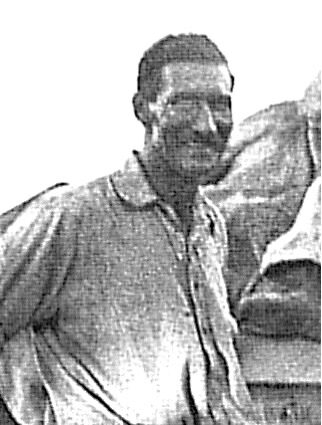‘Long Lou’ Llewellin and his Hats
‘Long Lou’, a six-foot-four, broad-shouldered man, ‘beloved of ladies and a very Bayard in battle,’ was Gloucestershire-born John Lionel Bretherton Llewellyn Llewellin. He wore an eyeglass and sandals, with often nothing in between when he was in remote areas. He was renowned for not wearing a hat, at a time when no white Kenyan would go out in the midday sun without a felt double-terai or a cork sola topee. Llewellin first heard that he should be wearing a hat when he was en route to Kenya in 1914. On his ship’s arrival in Port Said Lord Delamere, a fellow passenger, asked why Llewellin was not wearing a hat, for he himself was wearing an unusually long sola topee spreading two feet from front to back. Llewellin visited Port Said’s famous Simon Arzt’s emporium and purchased two helmets, a white pith one and a khaki-covered one covered with small bits of cork, commonly called the ‘Bombay Bowler.’ Unfortunately, he wore the white one during the ceremony of crossing the Equator; it was left so badly discoloured and battered that he later gave it to his cook who wore it on safaris.
Llewellin was appointed to an administrative post in the Northern Frontier District. From the Blue Posts Hotel at Thika he boarded ox wagons under the charge of a West African called ‘Tom Coffee,’ the ruler with a rod of iron of native African drivers. Tom Coffee called his men ‘black bastards’ though himself was a shade darker than many of them. They in turn called him the ‘Black European.’
Wearing his khaki helmet, Llewellin took a week to reach Nyeri, then consisting of six government houses, two of them in the old fort later occupied by most of the government offices, Sandy Herd’s Emporium, which included the post office, and a few Indian dukas, one of them belonging to the famous Osman Allu.
Llewllin travelled on by ox wagon to Archer’s Post, reaching it on 20 June 1914. His living quarters were a large tent and his office a rickety building of wattle and daub with a grass roof. He was greeted by Stevens, a clerk of Anglo-Indian decent, and a Sudanese corporal of the Special Northern Frontier Constabulary. He then travelled to Wajir. He himself takes up the story: ‘All this time I have been wearing my one remaining sun helmet, and I had been at Wajir about two months when, on a mule trip to one of the main groups of wells in the area, a sudden downpour soaked my headgear to such an extent that it became unwearable, and thereafter, for some time I used on occasions a shabby old homburg, but in the end gave it up. I took over the district about a year later, and in all spent some six years there. The only time I left for civilization was in 1917, when a much-postponed trip to the dentist in Nairobi became essential. It took the best part of a month to get there, and I arrived with a bad dose of malaria, which I had picked up during the heavy rains earlier in the year, and I spent my first fortnight in hospital. When I recovered and could get about during the balance of my month’s local leave, I found myself famous by not wearing a hat against all convention. I was warned time and time again that I would ruin my health, but having spent between two and three years in the hottest part of the country without wearing a hat, and having had no ill consequences, I refused to conform. Three years later when I finally left to go on long leave I was again attacked in Nairobi on the same grounds.’
After his wife died, Llewellin in later life lived in a small cottage near Nanyuki Club. The locals called him ‘John Hollowlegs.’ Sharp every morning at 11 o’clock, he arrived to sit on his stool at the end of the Club’s long bar to order one bottle of Gilbey’s gin and a jar of Heinz pearl onions. A friend recalled ‘on each fill-up of his tumbler he flicked out from his left eye his monacle, and proceeded to put four or five onions into the bottom of the tumbler, then the gin and soda. That procedure would continue till that last drop of gin went to the tumbler followed by the vinegar out of the onion jar, whereupon he drank it and bade goodbye to all who were present. He would then walk perfectly upright to his car and drive home for lunch followed by a short nap on his bed. At 5:30 he would reappear at the club, take up his usual place, and order a bottle of John Haig whisky which he would consume in his own time before he retired from the club to drive himself home and to bed. This was his daily routine and he kept quite fit and healthy right up to about three weeks before his death’ on 19 January 1974. He was buried in Nanyuki cemetery.


Recent Comments